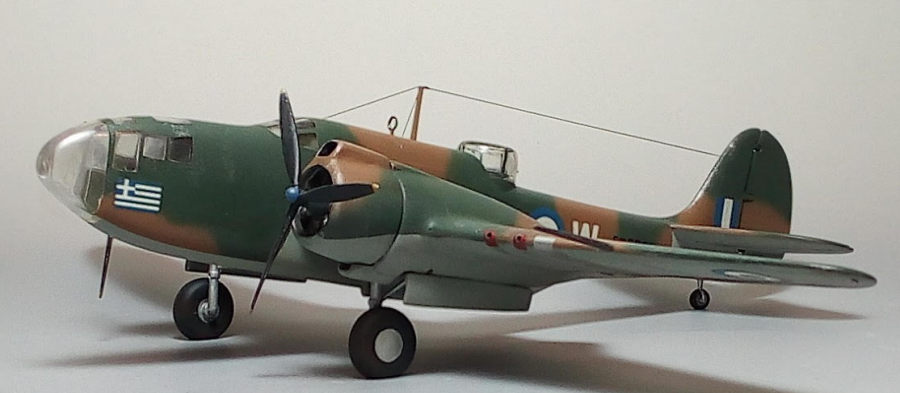
Novo/Frog 1/72 Martin Baltimore
| KIT #: | F-339 |
| PRICE: | €15 "used" in 2003 |
| DECALS: | Two options |
| REVIEWER: | Spiros Pendedekas |
| NOTES: |

| HISTORY |
The Martin 187 Baltimore
was a twin-engine light attack bomber that emerged from a French order, as a
follow-up to their earlier Maryland. With the fall of France, the production
series was diverted to Great Britain and, after mid-1941, supplied by the U.S.
as Lend Lease equipment.
A versatile combat aircraft, used almost exclusively in the Mediterranean and
Middle East theatre of World War II, though not serving with the United States,
it eventually served with the British, Canadian, Australian, South African,
Hellenic and Italian Air Forces.
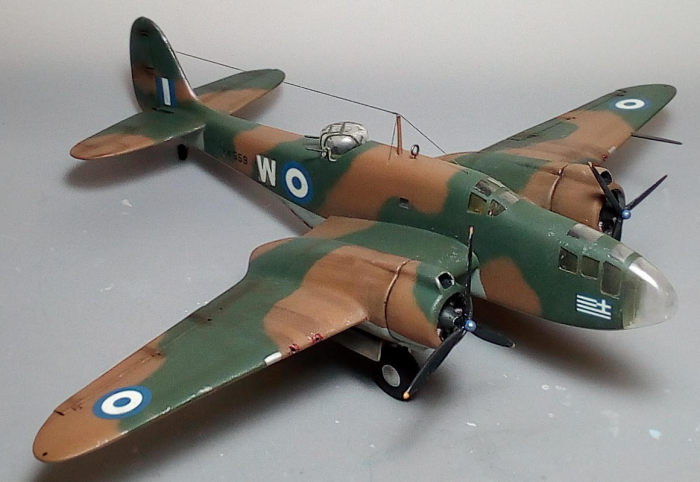 The 13th
Light Bombardment Squadron, a historic unit of the Hellenic Air Force, was
founded in June 1941 in Dekeila, Egypt. It was the first unit of the then Royal
Hellenic Air Force to be formed after the German invasion and occupation of
Greece, and the escape of most of the Air Force personnel in the Middle East,
where they joined the RAF.
The 13th
Light Bombardment Squadron, a historic unit of the Hellenic Air Force, was
founded in June 1941 in Dekeila, Egypt. It was the first unit of the then Royal
Hellenic Air Force to be formed after the German invasion and occupation of
Greece, and the escape of most of the Air Force personnel in the Middle East,
where they joined the RAF.
They initially flew five fled Avro Ansons, and were gradually equipped with
Blenheims IV and V. After many requests, the British decided to supply the 13th
Squadron with the more potent Baltimore. The aircraft were acquired from the
United States through the Lend - Lease Agreement and were used by the RAF almost
exclusively on the North African front.
In the spring of '44 the Squadron was transferred to Italy and in November of
the same year, they returned to partially free Greece with 16 Baltimores,
undertaking not only the bombing of German positions, but also search and rescue
missions and launching announcements and supplies.
By the end of WWII, the situation in the recently liberated Greece was going
from bad to worse, with Civil War soon to break out. It was obvious that the
Hellenic Air Force, taking its first post-war steps, would need all the aircraft
in its power, especially the Baltimore. However, in a seemingly inexplicable
move, RAF decided to withdraw the latter and replace them with obsolete and
unfit for the light bombing role Wellingtons!
Baltimores began returning to the RAF in August 1945, with the last three
aircraft leaving Greece on September 18, 1945, after an impressive display in
the skies of Athens. All aircraft flew to Kasfarit, Egypt from where they were
distributed to other RAF units, or ended up in scrap metal.
| THE KIT |
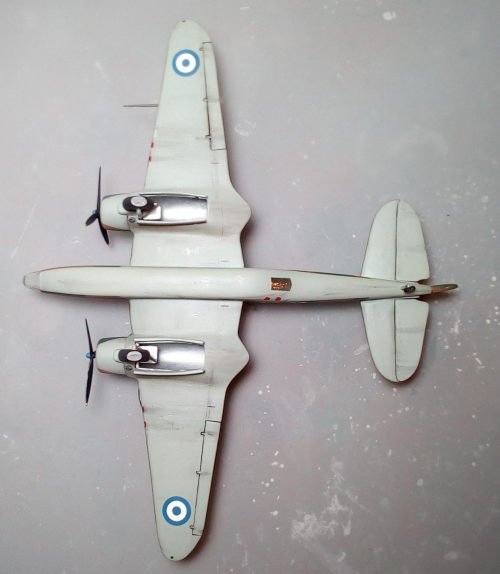 This kit
was introduced by Frog back in 1963, reissued until 1968. Then it was once
reboxed by Novo in 1978 and…that was it! My copy came "used" without a box, only
the parts sealed in a bag with the decals and Novo instructions included. Upon
opening the bag, I was greeted with the familiar ancient school Frog thick
styrene parts, a few attached to some kind of sprue trees, the rest of them
floating around. There was a lot of flash and the wings were warped.
This kit
was introduced by Frog back in 1963, reissued until 1968. Then it was once
reboxed by Novo in 1978 and…that was it! My copy came "used" without a box, only
the parts sealed in a bag with the decals and Novo instructions included. Upon
opening the bag, I was greeted with the familiar ancient school Frog thick
styrene parts, a few attached to some kind of sprue trees, the rest of them
floating around. There was a lot of flash and the wings were warped.
Detail is sparse, with practically nonexistent interior (only two crude crew members are provided, to be placed onto equally crude seats). There are no landing gear bays to speak of and the landing gear looks toy-ish. On the less offending side, the prominent engines and props are acceptable. Transparencies are thick and foggy, but the clear nose at least displays some kind of the characteristic semi-transparent framing that is prominent at Baltimore noses. Total parts count is 60.
Instructions come in the form of a double sided A4 photocopy with the not complicated construction spread in 9 steps, but no internal color callouts are given. The decal sheet is very basic and not so well done, depicting a French and an English bird. No camo drawings are provided whatsoever, but I have a feeling that they might have been printed on the back side of the Novo box, which I didn’t get! The Net proved to be very helpful here, as I quite easily found everything I needed!
| CONSTRUCTION |
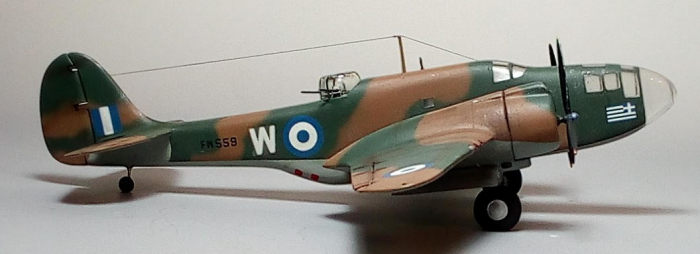 After
cleaning all parts as best as I could, I started by attaching the side windows
from the fuselage innards, then painted all interior (including pilot and gunner
seats and turret housing) Hu226 interior green. The seats received belts made
from masking tape, and I went on joining the fuselage halves, with the cockpit
floor and the ventral window trapped between them. I then assembled the wings
and stabilators, all 3-piece affairs, and attached them onto the fuselage.
After
cleaning all parts as best as I could, I started by attaching the side windows
from the fuselage innards, then painted all interior (including pilot and gunner
seats and turret housing) Hu226 interior green. The seats received belts made
from masking tape, and I went on joining the fuselage halves, with the cockpit
floor and the ventral window trapped between them. I then assembled the wings
and stabilators, all 3-piece affairs, and attached them onto the fuselage.
The good looking 2-piece engines were assembled, painted black with dark
gray crankcases and heavily dry brushed with silver. The 2-piece cowlings were
assembled, filled, sanded, had their innards painted steel and, after receiving
the engines, they were attached in place. The two piece rudder, the canopy and
the clear nose were attached as well, with the rudder (and tail wheel) offset to
the left, to add some life to this otherwise simplistic build. Overall fit, as
expected, was not good, with the here and there gaps taken care of with
rigorous filling and sanding. After masking the canopy, the clear nose and side
windows, I blocked the engine openings with wet tissue and headed to the paint
shop!
| COLORS AND MARKINGS |
Baltimores operated by HAF were quite interesting regarding their camo: most of them initially wore the standard (and very nice!) RAF desert camo. Gradually, HAF personnel might have at times added Greek flags at front fuselage sides and overpaint RAF red with blue at the fuselage insignia. Accomplished bombing missions, Greek island names and blue prop hubs were also spotted. Upon returning to Greece, during their brief stay there, an unidentified number of those planes were hastily repainted in a dark green/dark brown over light blue camo, with Hellenic insignia added, but retaining the English coding and serial numbers. I thus decided to use “artistic license”, in order to depict such a plane, the s/n FW559 “W”, one of the 16 that arrived in Greece in 1944, of which no known photo evidence of its HAF days seems to exist.
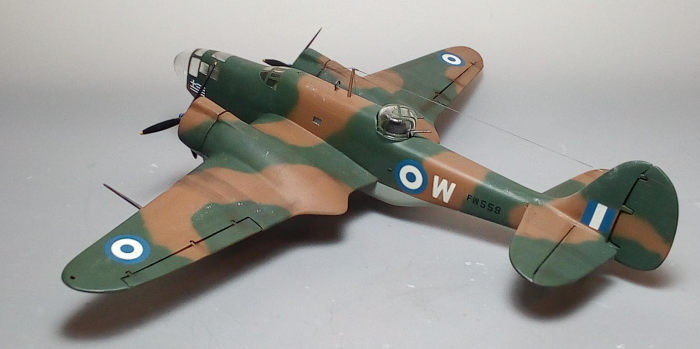 I first
applied a coat of Hu65 light blue at the undersides, including gear doors, and
masked them off. I then freehanded the dark brown/dark green top camo
(Hu28/Hu102), "tightening" the demarcation lines with my airbrush at its finest
settings. I was not very picky about the camo pattern and color shades:
understandably, at those harsh times, HAF personnel would paint the plane with
whatever they had available…
I first
applied a coat of Hu65 light blue at the undersides, including gear doors, and
masked them off. I then freehanded the dark brown/dark green top camo
(Hu28/Hu102), "tightening" the demarcation lines with my airbrush at its finest
settings. I was not very picky about the camo pattern and color shades:
understandably, at those harsh times, HAF personnel would paint the plane with
whatever they had available…
After removing the underside masking, I gave the model a coat of Future and went
on to apply the HAF insignia, which came from an excellent (sadly out of
production, seemingly for good) Kalfakis-Afterburner, Cartograf printed sheet.
The plane's s/n and white “W” code came from leftovers. I also decided to apply
two Greek flags bilaterally on the nose sides (they came from the same above
Kalfakis-Afterburner sheet). I finally hand painted the four red squares around
the wing guns.
Since those planes were hastily painted and put to intensive operational use, I
decided to add a bit of weathering. This included engine staining, oil/grease
leaking, mud dirtying (all done with suitable colored dry pastels) and some
chipping done by silver dry brushing. A coat of Future sealed everything.
| FINAL BITS |
I attached the MLG legs,
followed by the main wheels and tail wheel assembly, which was glued at an angle
as the rudder. Overall landing gear components color was steel, the oleos
highlighted using my fine silver pen. Tires were black, and were filed to look
weighted. The good looking props received steel hubs, blue hub cowlings, black
blades and yellow tips. After some silver dry brushing, they were affixed in
place. The oil cooler intake innards were painted black, to give an illusion of
depth.
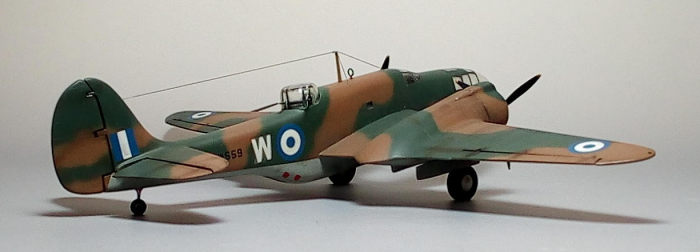 The antenna
mast and DF loop antenna were attached in position. Three pieces of stretched
sprue were accordingly run as per the reference pics and were tightened by hot
air from a hairdryer. The port wing pitot, though somehow unrefined, was painted
gun metal and used anyway. The whole model then received its final matt coat (no
chance of glossiness during those harsh conditions…).
The antenna
mast and DF loop antenna were attached in position. Three pieces of stretched
sprue were accordingly run as per the reference pics and were tightened by hot
air from a hairdryer. The port wing pitot, though somehow unrefined, was painted
gun metal and used anyway. The whole model then received its final matt coat (no
chance of glossiness during those harsh conditions…).
I removed the transparency masks, hand painted the two leading edge approach lights with chrome silver and represented the wingtip lights with blobs of red and green clear paint. The gunner’s turret was assembled, had its innards painted interior green, its framing hand painted as per the fuselage camo and its gun painted gunmetal. Its base lugs were removed and it was attached in position at an angle, as yet another attempt to breathe some life to this plain model. I then called this bird done!
| CONCLUSIONS |
With 1575 examples
built, it is somehow interesting that, apart from the ancient and by all means
obsolete Frog/Novo, no mainstream Baltimore kit of any scale exists whatsoever.
As of 2021, the only other options were the seemingly very good, but limited
run, 1/48 Classic Airframes and 1/72 Azur/Special Hobby kits, all issued at
about 2007-2008, not easily found today. Due to its widespread use by the RAF, I
will not be surprised if the “new” Airfix will come up with a mainstream
Baltimore at some future point.
The Frog/Novo kit is by all means an ancient kit (and very difficult to find),
providing only the basic shape of the Baltimore (of which I cannot comment other
than it looks like a Baltimore), without any serious detailing whatsoever, apart
from the engines, which look acceptable. While fit is not great, it is not a
very difficult build and can be even tackled by the average modeler. I cannot
comment about decals' quality, as I did not use them, however, them being so
old, I would definitely recommend going aftermarket or robbing your decal
dungeon.
I will not deny that I had a pleasant time building this oldie, especially due
to my “allowance” of using my judicious thinking, trying to depict a probable
scheme, of which minimal evidence exists.
Happy modeling!
Spiros
Pendedekas
21 January 2022
Copyright ModelingMadness.com. All rights reserved. No reproduction in part or in whole without express permission.
If you would like your product reviewed fairly and fairly quickly, please contact the editor or see other details in the Note to Contributors.